Viability of a Single-Stage Unsaturated-Saturated Granular Activated Carbon Biofilter for Greywater Treatment
Abstract
1. Introduction
2. Materials and Methods
2.1. Greywater Formulation
2.2. GAC Biofilter Setup
2.3. Feeding Strategy and Operation Stages
2.4. Water Sampling and Analysis
2.5. Biofilm Growth and Biological Activity
2.6. Reduction of Microbial Surrogates
2.6.1. Tracer Test
2.6.2. Pathogen Surrogate Study Overview
2.7. DNA Extraction and Microbial Community Analysis
3. Results and Discussion
3.1. Treatment Performance
3.2. Biofilm Growth and Biological Activity
3.3. Reduction of Pathogen Surrogates
3.4. Microbial Community Structure
3.5. Feasibility and Implications for Design and Operation
4. Conclusions
Supplementary Materials
Author Contributions
Funding
Conflicts of Interest
References
- Chen, Z.; Ngo, H.H.; Guo, W. A Critical Review on the End Uses of Recycled Water. Crit. Rev. Environ. Sci. Technol. 2013, 43, 1446–1516. [Google Scholar] [CrossRef]
- Al-Jayyousi, O. Focused environmental assessment of greywater reuse in Jordan. Environ. Eng. Policy 2001, 3, 67–73. [Google Scholar] [CrossRef]
- Masi, F.; Rizzo, A.; Regelsberger, M. The role of constructed wetlands in a new circular economy, resource oriented, and ecosystem services paradigm. J. Environ. Manag. 2018, 216, 275–284. [Google Scholar] [CrossRef] [PubMed]
- Leong, J.Y.C.; Chong, M.N.; Poh, P.E.; Vieritz, A.; Talei, A.; Chow, M.F. Quantification of mains water savings from decentralised rainwater, greywater, and hybrid rainwater-greywater systems in tropical climatic conditions. J. Clean. Prod. 2018, 176, 946–958. [Google Scholar] [CrossRef]
- Ilemobade, A.A.; Olanrewaju, O.O.; Griffioen, M.L. Greywater reuse for toilet flushing at a university academic and residential building. Water SA 2013, 39, 351–360. [Google Scholar] [CrossRef][Green Version]
- Maimon, A.; Tal, A.; Friedler, E.; Gross, A. Safe on-Site Reuse of Greywater for Irrigation—A Critical Review of Current Guidelines. Environ. Sci. Technol. 2010, 44, 3213–3220. [Google Scholar] [CrossRef]
- Maimon, A.; Gross, A.; Arye, G. Greywater-induced soil hydrophobicity. Chemosphere 2017, 184, 1012–1019. [Google Scholar] [CrossRef]
- Wiel-Shafran, A.; Ronen, Z.; Weisbrod, N.; Adar, E.; Gross, A. Potential changes in soil properties following irrigation with surfactant-rich greywater. Ecol. Eng. 2006, 26, 348–354. [Google Scholar] [CrossRef]
- Shafran, A.W.; Gross, A.; Ronen, Z.; Weisbrod, N.; Adar, E. Effects of surfactants originating from reuse of greywater on capillary rise in the soil. Water Sci. Technol. 2005, 52, 157–166. [Google Scholar] [CrossRef]
- Shi, K.W.; Wang, C.W.; Jiang, S.C. Quantitative microbial risk assessment of Greywater on-site reuse. Sci. Total Environ. 2018, 635, 1507–1519. [Google Scholar] [CrossRef]
- Schoen, M.E.; Ashbolt, N.J.; Jahne, M.A.; Garland, J. Risk-based enteric pathogen reduction targets for non-potable and direct potable use of roof runoff, stormwater, and greywater. Microb. Risk Anal. 2017, 5, 32–43. [Google Scholar] [CrossRef] [PubMed]
- Schoen, M.E.; Garland, J. Review of pathogen treatment reductions for onsite non-potable reuse of alternative source waters. Microb. Risk Anal. 2017, 5, 25–31. [Google Scholar] [CrossRef]
- Capodaglio, A. Integrated, Decentralized Wastewater Management for Resource Recovery in Rural and Peri-Urban Areas. Resources 2017, 6, 22. [Google Scholar] [CrossRef]
- Ghawi, A.H. Development of the greywater domestic treatment unit for irrigation of the garden in rural areas. J. Ecol. Eng. 2019, 20, 46–56. [Google Scholar] [CrossRef]
- Moges, M.E.; Todt, D.; Eregno, F.E.; Heistad, A. Performance study of biofilter system for on-site greywater treatment at cottages and small households. Ecol. Eng. 2017, 105, 118–124. [Google Scholar] [CrossRef]
- Avery, L.M.; Frazer-Williams, R.A.D.; Winward, G.; Shirley-Smith, C.; Liu, S.; Memon, F.A.; Jefferson, B. Constructed wetlands for grey water treatment. Ecohydrol. Hydrobiol. 2007, 7, 191–200. [Google Scholar] [CrossRef]
- Fowdar, H.S.; Hatt, B.E.; Breen, P.; Cook, P.L.M.; Deletic, A. Designing living walls for greywater treatment. Water Res. 2017, 110, 218–232. [Google Scholar] [CrossRef]
- Prodanovic, V.; Hatt, B.; McCarthy, D.; Zhang, K.; Deletic, A. Green walls for greywater reuse: Understanding the role of media on pollutant removal. Ecol. Eng. 2017, 102, 625–635. [Google Scholar] [CrossRef]
- Jenssen, P.D.; Vråle, L. Greywater Treatment in combined Biofilter/Constructed Wetlands in Cold Climate. In Proceedings of the Second International Conference on Ecological Sanitation, Lübeck, Germany, 7–11 April 2003; pp. 875–881. [Google Scholar]
- Sharaf, A.; Liu, Y. Mechanisms and kinetics of greywater treatment using biologically active granular activated carbon. Chemosphere 2021, 263, 128113. [Google Scholar] [CrossRef]
- Aktaş, Ö.; Çeçen, F. Bioregeneration of activated carbon: A review. Int. Biodeterior. Biodegrad. 2007, 59, 257–272. [Google Scholar] [CrossRef]
- Ahmaruzzaman, M. Adsorption of phenolic compounds on low-cost adsorbents: A review. Adv. Colloid Interface Sci. 2008, 143, 48–67. [Google Scholar] [CrossRef] [PubMed]
- Snyder, S.A.; Adham, S.; Redding, A.M.; Cannon, F.S.; DeCarolis, J.; Oppenheimer, J.; Wert, E.C.; Yoon, Y. Role of membranes and activated carbon in the removal of endocrine disruptors and pharmaceuticals. Desalination 2007, 202, 156–181. [Google Scholar] [CrossRef]
- Toles, C.A.; Marshall, W.E.; Johns, M.M. Granular activated carbons from nutshells for the uptake of metals and organic compounds. Carbon 1997, 35, 1407–1414. [Google Scholar] [CrossRef]
- Ahmed, M.B.; Zhou, J.L.; Ngo, H.H.; Guo, W. Adsorptive removal of antibiotics from water and wastewater: Progress and challenges. Sci. Total Environ. 2015, 532, 112–126. [Google Scholar] [CrossRef]
- Heistad, A.; Jenssen, P.D.; Frydenlund, A.S. A new combined distribution and pretreatment unit for wastewater soil infiltration systems. In Proceedings of the On-Site Wastewater Treatment, Fort Worth, TX, USA, 11–14 March 2001; American Society of Agricultural and Biological Engineers: St. Joseph, MI, USA, 2001; pp. 200–206. [Google Scholar]
- Dalahmeh, S.S.; Pell, M.; Vinnerås, B.; Hylander, L.D.; Öborn, I.; Jönsson, H. Efficiency of Bark, Activated Charcoal, Foam and Sand Filters in Reducing Pollutants from Greywater. Water Air Soil Pollut. 2012, 223, 3657–3671. [Google Scholar] [CrossRef]
- Eregno, F.E.; Heistad, A. On-site treated wastewater disposal systems—The role of stratified filter medias for reducing the risk of pollution. Environ. Int. 2019, 124, 302–311. [Google Scholar] [CrossRef] [PubMed]
- NSF International. NSF/ANSI 350: On-Site Residential and Commercial Water Reuse Treatment Systems; NSF International: Ann Arbor, MI, USA, 2012. [Google Scholar]
- Bruno, L. Standard Methods for the Examination of Water and Wastewater, 23rd ed.; Rice, E.W., Barid, A.D., Eaton, A.D., Eds.; American Public Health Association: Washington, DC, USA, 2017; Volume 53, ISBN 9780875532875. [Google Scholar]
- Velten, S.; Hammes, F.; Boller, M.; Egli, T. Rapid and direct estimation of active biomass on granular activated carbon through adenosine tri-phosphate (ATP) determination. Water Res. 2007, 41, 1973–1983. [Google Scholar] [CrossRef]
- Kadlec, R.H.; Wallace, S.D. Treatment Wetlands; CRC Press: Boca Raton, FL, USA, 2009; ISBN 9781566705264. [Google Scholar]
- Method 1601: Male-specific (F+) and Somatic Coliphage in Water by Two-Step Enrichment Procedure; United States Environmental Protection Agency: Boston, MA, USA, 2001.
- Apprill, A.; Mcnally, S.; Parsons, R.; Weber, L. Minor revision to V4 region SSU rRNA 806R gene primer greatly increases detection of SAR11 bacterioplankton. Aquat. Microb. Ecol. 2015, 75, 129–137. [Google Scholar] [CrossRef]
- Parada, A.E.; Needham, D.M.; Fuhrman, J.A. Every base matters: Assessing small subunit rRNA primers for marine microbiomes with mock communities, time series and global field samples. Environ. Microbiol. 2016, 18, 1403–1414. [Google Scholar] [CrossRef] [PubMed]
- Werner, J.J.; Koren, O.; Hugenholtz, P.; DeSantis, T.Z.; Walters, W.A.; Caporaso, J.G.; Angenent, L.T.; Knight, R.; Ley, R.E. Impact of training sets on classification of high-throughput bacterial 16s rRNA gene surveys. ISME J. 2012, 6, 94–103. [Google Scholar] [CrossRef]
- Callahan, B.J.; McMurdie, P.J.; Rosen, M.J.; Han, A.W.; Johnson, A.J.A.; Holmes, S.P. DADA2: High-resolution sample inference from Illumina amplicon data. Nat. Methods 2016, 13, 581–583. [Google Scholar] [CrossRef] [PubMed]
- Oksanen, J.; Blanchet, F.G.; Friendly, M.; Kindt, R.; Legendre, P.; McGlinn, D.; Minchin, P.R.; O’Hara, R.B.; Sompson, G.L.; Solymos, P.; et al. vegan: Community Ecology Package: Ordination Methods, Diversity Analysis and Other Functions for Community and Vegetation Ecologists. 2019. Available online: https://cran.r-project.org/web/packages/vegan/index.html (accessed on 20 February 2020).
- González-García, C.M.; González-Martín, M.L.; Denoyel, R.; Gallardo-Moreno, A.M.; Labajos-Broncano, L.; Bruque, J.M. Ionic surfactant adsorption onto activated carbons. J. Colloid Interface Sci. 2004, 278, 257–264. [Google Scholar] [CrossRef] [PubMed]
- Wu, S.H.; Pendleton, P. Adsorption of Anionic Surfactant by Activated Carbon: Effect of Surface Chemistry, Ionic Strength, and Hydrophobicity. J. Colloid Interface Sci. 2001, 243, 306–315. [Google Scholar] [CrossRef]
- González, S.; Petrovic, M.; Barceló, D. Removal of a broad range of surfactants from municipal wastewater—Comparison between membrane bioreactor and conventional activated sludge treatment. Chemosphere 2007, 67, 335–343. [Google Scholar] [CrossRef]
- Mungray, A.K.; Kumar, P. Anionic surfactants in treated sewage and sludges: Risk assessment to aquatic and terrestrial environments. Bioresour. Technol. 2008, 99, 2919–2929. [Google Scholar] [CrossRef]
- Moges, M.E.; Eregno, F.E.; Heistad, A. Performance of biochar and filtralite as polishing step for on-site greywater treatment plant. Manag. Environ. Qual. Int. J. 2015, 26, 607–625. [Google Scholar] [CrossRef]
- Draft Guidelines for the Reuse of Greywater in Western Australia; Health Department of Western Australia: Perth, Australia, 2002.
- Todt, D.; Heistad, A.; Jenssen, P.D. Load and distribution of organic matter and nutrients in a separated household wastewater stream. Environ. Technol. 2015, 36, 1584–1593. [Google Scholar] [CrossRef]
- Ha, S.R.; Vinitnantharat, S.; Ozaki, H. Bioregeneration by mixed microorganisms of granular activated carbon loaded with a mixture of phenols. Biotechnol. Lett. 2000, 22, 1093–1096. [Google Scholar] [CrossRef]
- Hijnen, W.A.M.; Suylen, G.M.H.; Bahlman, J.A.; Brouwer-Hanzens, A.; Medema, G.J. GAC adsorption filters as barriers for viruses, bacteria and protozoan (oo)cysts in water treatment. Water Res. 2010, 44, 1224–1234. [Google Scholar] [CrossRef]
- Afrooz, A.R.M.N.; Boehm, A.B. Escherichia coli Removal in Biochar-Modified Biofilters: Effects of Biofilm. PLoS ONE 2016, 11, e0167489. [Google Scholar] [CrossRef]
- Díaz, C.; Cortizo, M.C.; Schilardi, P.L.; de Saravia, S.G.G.; de Mele, M.A.F.L. Influence of the nano-micro structure of the surface on bacterial adhesion. Mater. Res. 2007, 10, 11–14. [Google Scholar] [CrossRef]
- Arnold, J.W.; Bailey, G.W. Surface finishes on stainless steel reduce bacterial attachment and early biofilm formation: Scanning electron and atomic force microscopy study. Poult. Sci. 2000, 79, 1839–1845. [Google Scholar] [CrossRef] [PubMed]
- Guy, M.D.; McIver, J.D.; Lewis, M.J. The removal of virus by a pilot treatment plant. Water Res. 1977, 11, 421–428. [Google Scholar] [CrossRef]
- Scott, T.M.; Sabo, R.C.; Lukasik, J.; Boice, C.; Shaw, K.; Barroso-Giachetti, L.; El-Shall, H.; Farrah, S.R.; Park, C.; Moudgil, B.; et al. Performance and Cost-Effectiveness of Ferric and Aluminum Hydrous Metal Oxide Coating on Filter Media to Enhance Virus Removal. KONA Powder Part. J. 2002, 20, 159–167. [Google Scholar] [CrossRef][Green Version]
- Persson, F.; Långmark, J.; Heinicke, G.; Hedberg, T.; Tobiason, J.; Stenström, T.A.; Hermansson, M. Characterisation of the behaviour of particles in biofilters for pre-treatment of drinking water. Water Res. 2005, 39, 3791–3800. [Google Scholar] [CrossRef]
- Tufenkji, N.; Elimelech, M. Breakdown of colloid filtration theory: Role of the secondary energy minimum and surface charge heterogeneities. Langmuir 2005, 21, 841–852. [Google Scholar] [CrossRef]
- Tufenkji, N.; Elimelech, M. Deviation from the classical colloid filtration theory in the presence of repulsive DLVO interactions. Langmuir 2004, 20, 10818–10828. [Google Scholar] [CrossRef]
- Molnar, I.L.; Johnson, W.P.; Gerhard, J.I.; Willson, C.S.; O’Carroll, D.M. Predicting colloid transport through saturated porous media: A critical review. Water Resour. Res. 2015, 51, 6804–6845. [Google Scholar] [CrossRef]
- Peng, J.; Cao, Y.; Rippy, M.; Afrooz, A.; Grant, S.; Peng, J.; Cao, Y.; Rippy, M.A.; Afrooz, A.R.M.N.; Grant, S.B. Indicator and Pathogen Removal by Low Impact Development Best Management Practices. Water 2016, 8, 600. [Google Scholar] [CrossRef]
- Zhang, L.; Seagren, E.A.; Davis, A.P.; Karns, J.S. The Capture and Destruction of Escherichia coli from Simulated Urban Runoff Using Conventional Bioretention Media and Iron Oxide-coated Sand. Water Environ. Res. 2010, 82, 701–714. [Google Scholar] [CrossRef]
- Zhang, L.; Seagren, E.A.; Davis, A.P. Column Studies on the Capture and Destruction of E. coli from Simulated Urban Stormwater Runoff Using Conventional Bioretention Media and Iron Oxide-Coated Sand. In Proceedings of the World Environmental and Water Resources Congress 2008, Honolulu, HI, USA, 12–16 May 2008; American Society of Civil Engineers: Reston, VA, USA, 2008; pp. 1–7. [Google Scholar]
- Kanamori, T.; Rashid, N.; Morikawa, M.; Atomi, H.; Imanaka, T. Oleomonas sagaranensis gen. nov., sp. nov., represents a novel genus in the α- Proteobacteria. FEMS Microbiol. Lett. 2002, 217, 255–261. [Google Scholar] [CrossRef]
- Dalahmeh, S.S.; Jönsson, H.; Hylander, L.D.; Hui, N.; Yu, D.; Pell, M. Dynamics and functions of bacterial communities in bark, charcoal and sand filters treating greywater. Water Res. 2014, 54, 21–32. [Google Scholar] [CrossRef] [PubMed]
- McIlroy, S.J.; Saunders, A.M.; Albertsen, M.; Nierychlo, M.; McIlroy, B.; Hansen, A.A.; Karst, S.M.; Nielsen, J.L.; Nielsen, P.H. MiDAS: The field guide to the microbes of activated sludge. Database 2015, 2015. [Google Scholar] [CrossRef]
- Guo, F.; Zhang, T.; Li, B.; Wang, Z.; Ju, F.; Liang, Y. ting Mycobacterial species and their contribution to cholesterol degradation in wastewater treatment plants. Sci. Rep. 2019, 9, 1–10. [Google Scholar] [CrossRef]
- Kertesz, M.A.; Kawasaki, A. Hydrocarbon-Degrading Sphingomonads: Sphingomonas, Sphingobium, Novosphingobium, and Sphingopyxis. In Handbook of Hydrocarbon and Lipid Microbiology; Springer: Berlin, Heidelberg, 2010; pp. 1693–1705. [Google Scholar]
- Song, N.; Cai, H.Y.; Yan, Z.S.; Jiang, H.L. Cellulose degradation by one mesophilic strain Caulobacter sp. FMC1 under both aerobic and anaerobic conditions. Bioresour. Technol. 2013, 131, 281–287. [Google Scholar] [CrossRef]
- Ye, L.; Zhang, T. Bacterial communities in different sections of a municipal wastewater treatment plant revealed by 16S rDNA 454 pyrosequencing. Appl. Microbiol. Biotechnol. 2013, 97, 2681–2690. [Google Scholar] [CrossRef]
- Hammes, W.P.; Vogel, R.F. The genus Lactobacillus. In The Genera of Lactic Acid Bacteria; Wood, B.J.B., Holzapfel, H.F., Eds.; Springer: Boston, MA, USA, 1995; Volume 2, pp. 19–54. [Google Scholar]
- Chung, B.S.; Ryu, S.H.; Park, M.; Jeon, Y.; Chung, Y.R.; Jeon, C.O. Hydrogenophaga caeni sp. nov., isolated from activated sludge. Int. J. Syst. Evol. Microbiol. 2007, 57, 1126–1130. [Google Scholar] [CrossRef] [PubMed][Green Version]
- Fernández, N.; Díaz, E.E.; Amils, R.; Sanz, J.L. Analysis of Microbial Community during Biofilm Development in an Anaerobic Wastewater Treatment Reactor. Microb. Ecol. 2008, 56, 121–132. [Google Scholar] [CrossRef] [PubMed]
- Anderson, R.C.; Yu, P.-L. Factors affecting the antimicrobial activity of ovine-derived cathelicidins against E. coli 0157:H7. Int. J. Antimicrob. Agents 2005, 25, 205–210. [Google Scholar] [CrossRef] [PubMed]
- Saimmai, A.; Rukadee, O.; Onlamool, T.; Sobhon, V.; Maneerat, S. Isolation and functional characterization of a biosurfactant produced by a new and promising strain of Oleomonas sagaranensis AT18. World J. Microbiol. Biotechnol. 2012, 28, 2973–2986. [Google Scholar] [CrossRef] [PubMed]
- Ghaitidak, D.M.; Yadav, K.D. Characteristics and treatment of greywater—A review. Environ. Sci. Pollut. Res. 2013, 20, 2795–2809. [Google Scholar] [CrossRef] [PubMed]
- Çeçen, F.; Aktaş, O. Activated Carbon for Water and Wastewater Treatment: Integration of Adsorption and Biological Treatment; Wiley-VCH: Weinheim, Germany, 2012; ISBN 9783527324712. [Google Scholar]
- Lazarova, V.; Hills, S.; Birks, R. Using recycled water for non-potable, urban uses: A review with particular reference to toilet flushing. Water Sci. Technol. Water Supply 2003, 3, 69–77. [Google Scholar] [CrossRef]
- Water Reuse in Alberta: Experience and Impacts on Economic Growth; WaterSMART Solutions Ltd.: Calgary, AB, Canada, 2013; p. 74.
- Toze, S. Reuse of effluent water—Benefits and risks. Agric. Water Manag. 2006, 80, 147–159. [Google Scholar] [CrossRef]
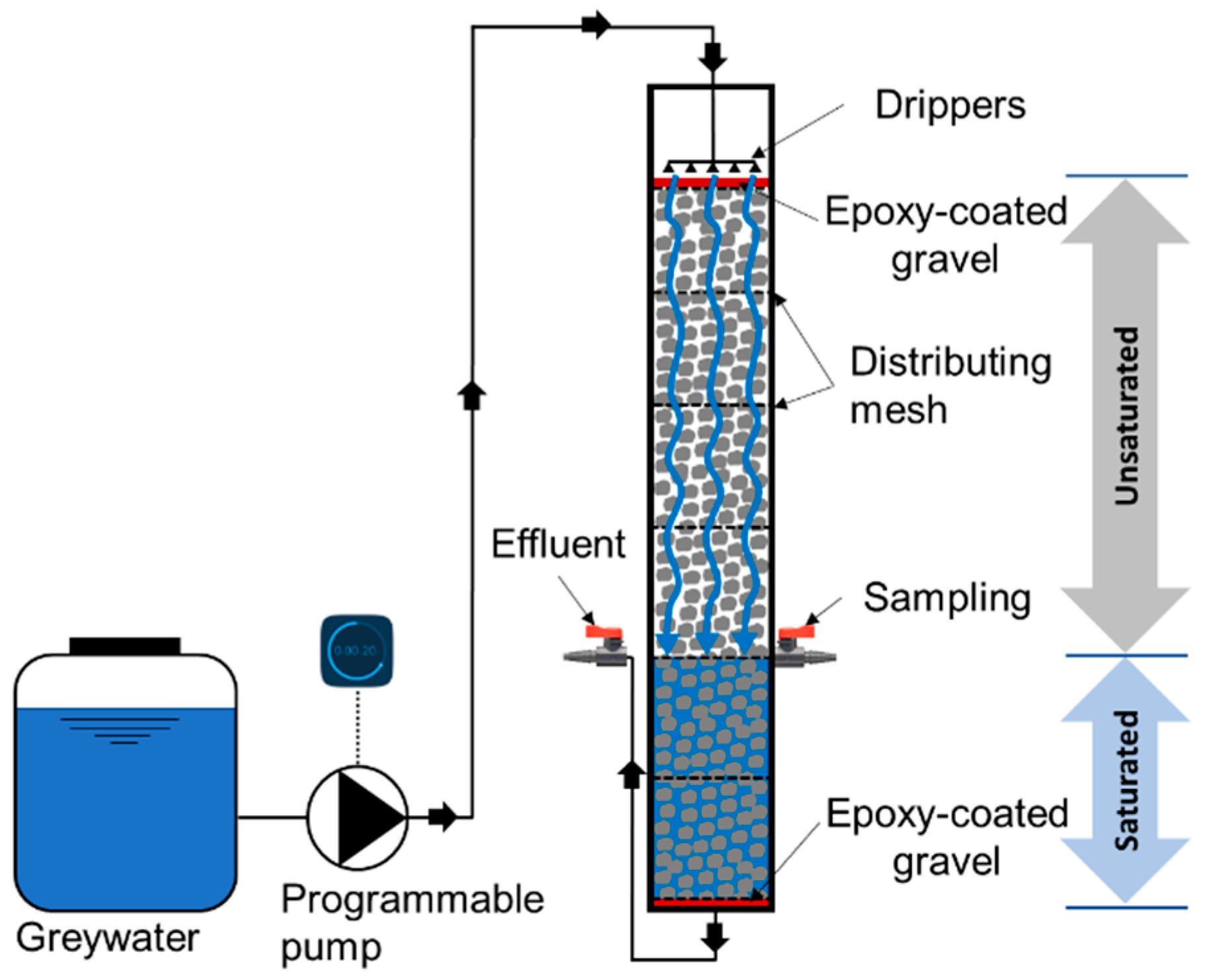
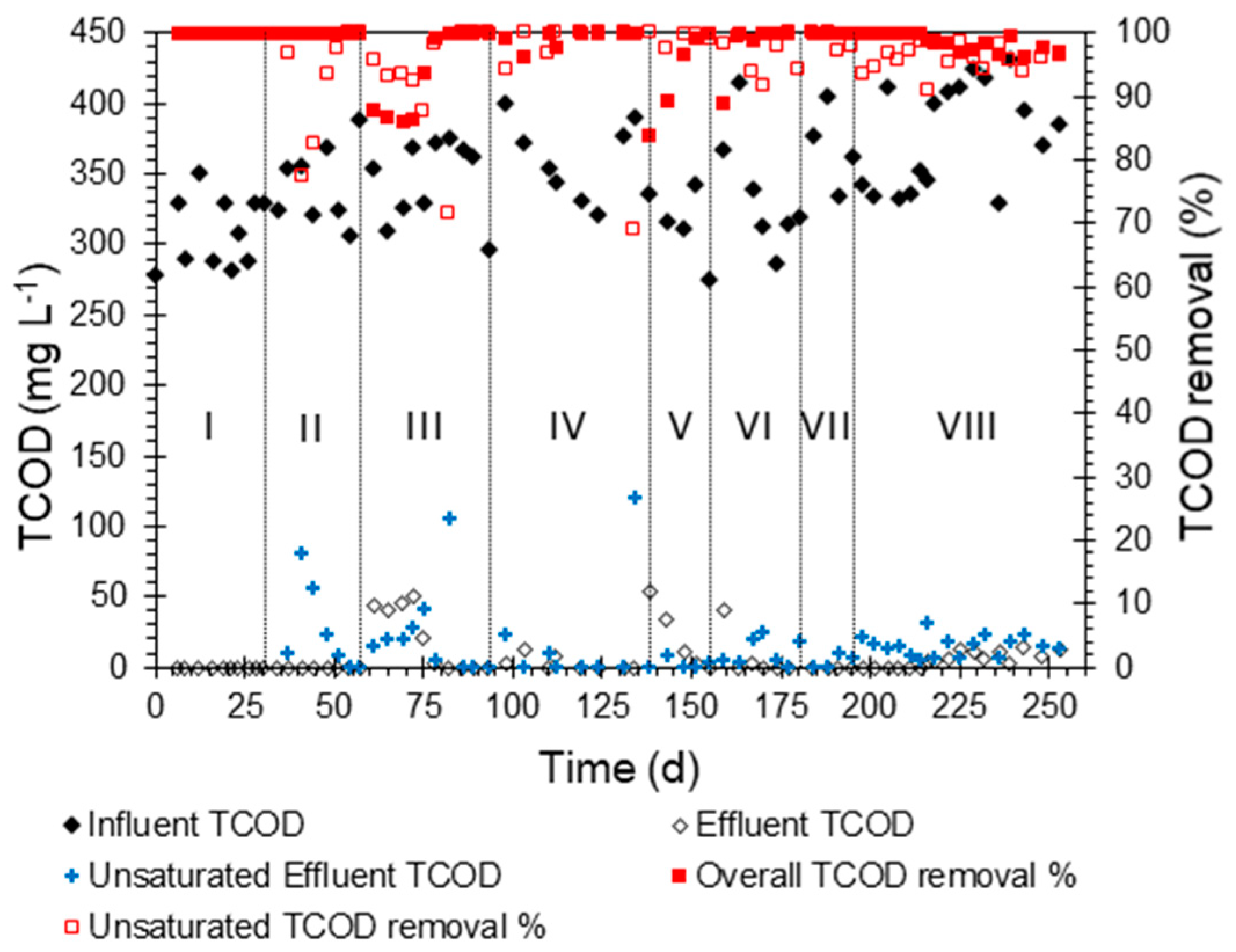

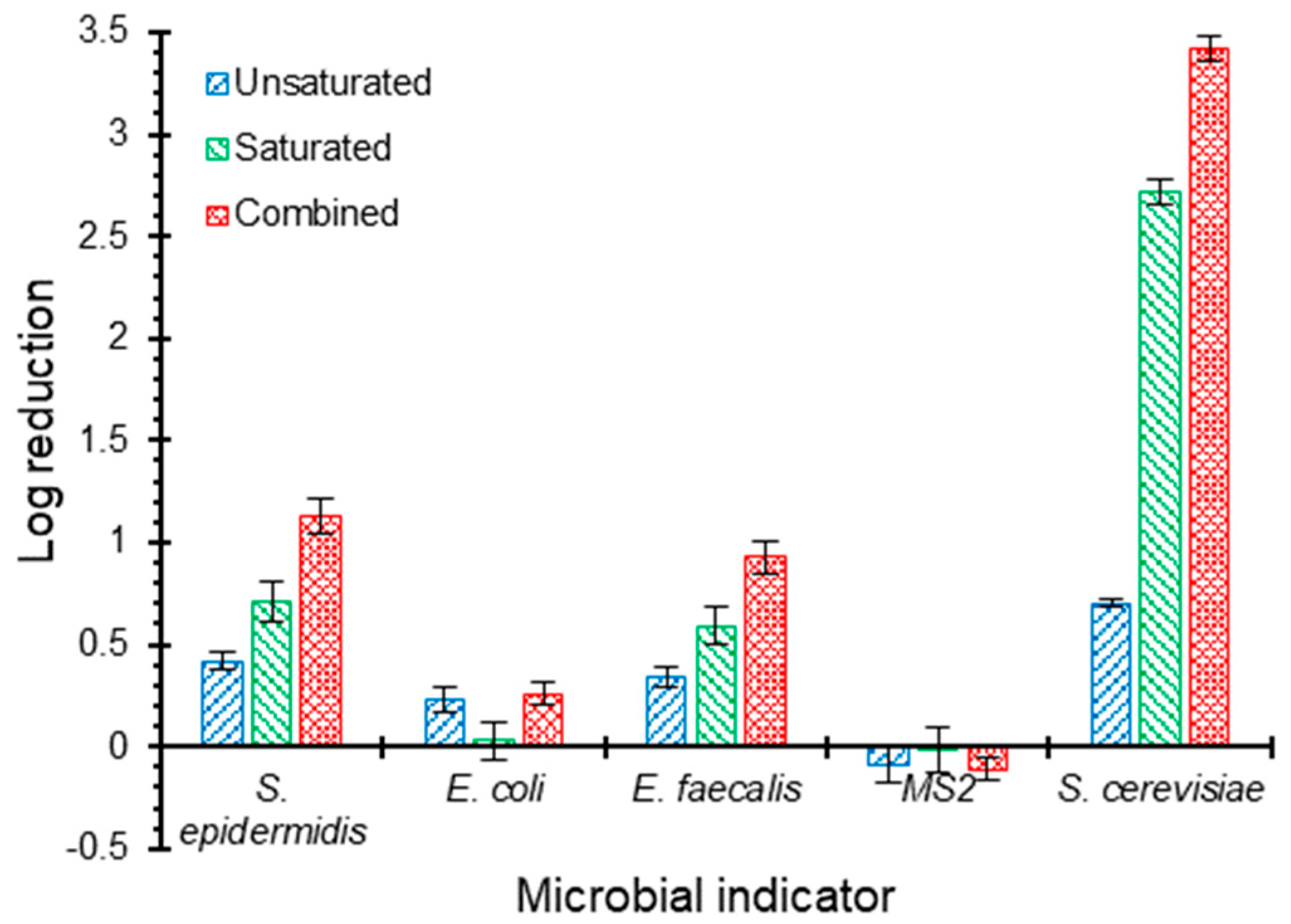
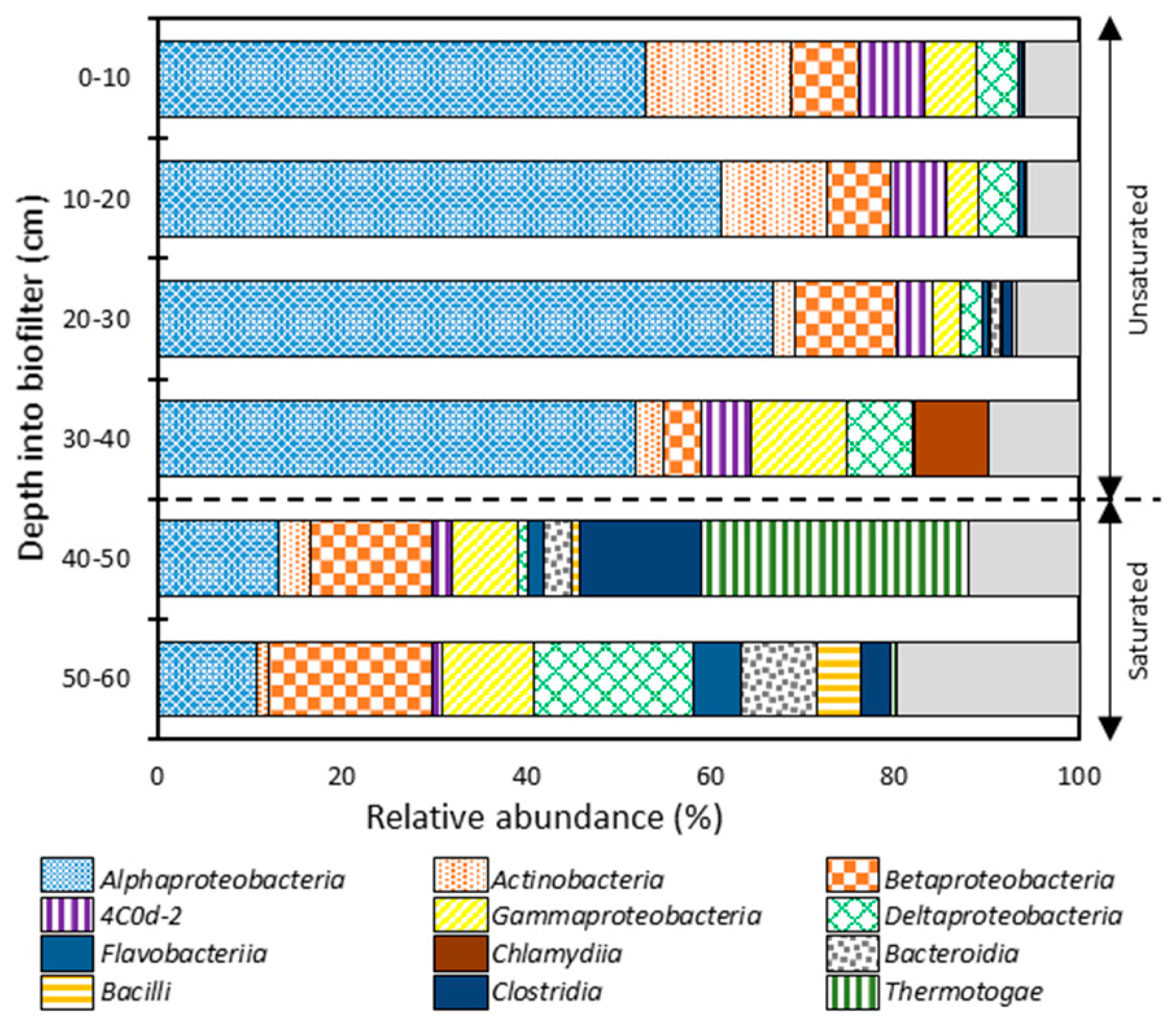
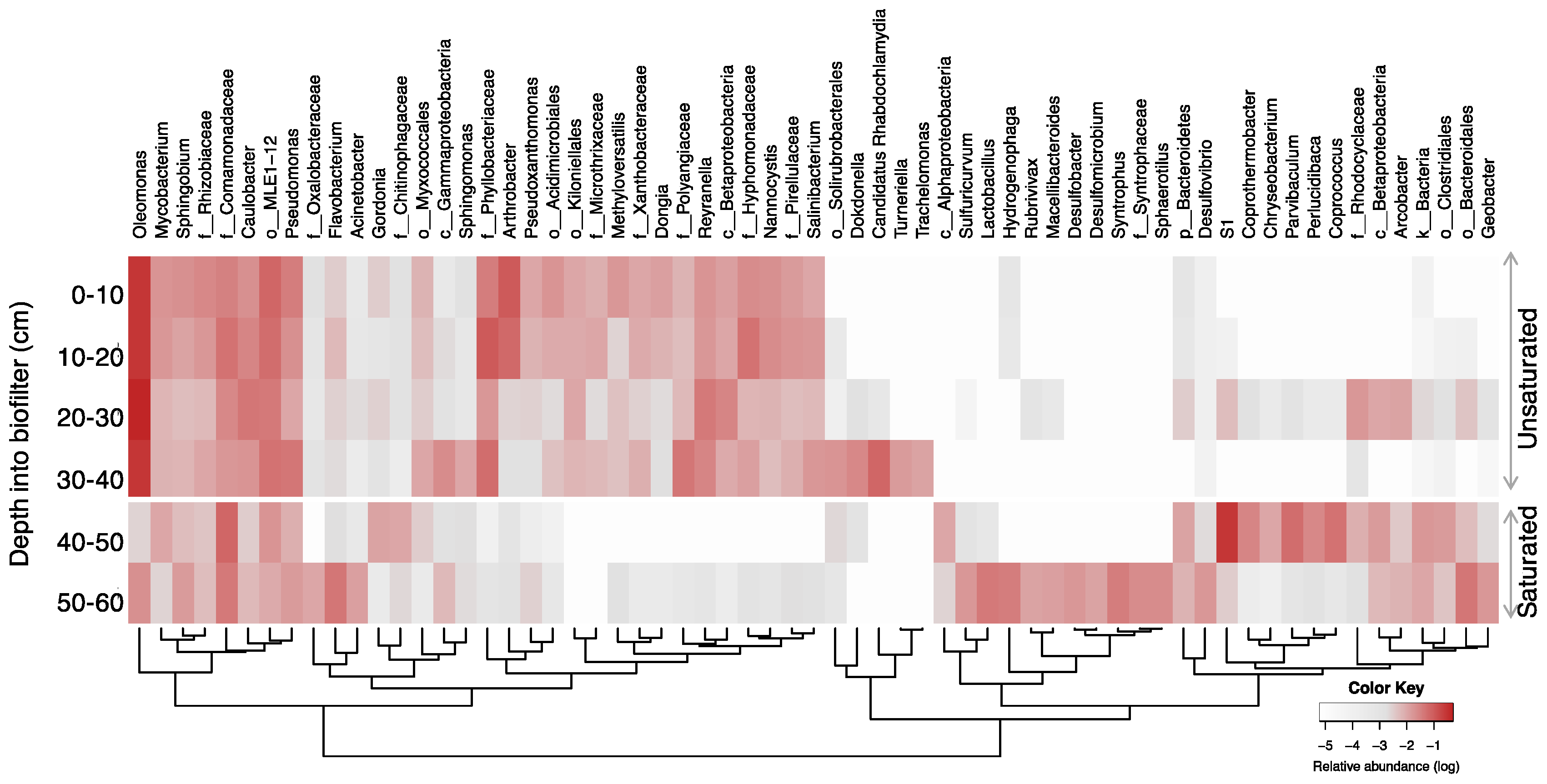
| Parameter | Unit | Value | Targeted Range 1 |
|---|---|---|---|
| Total chemical oxygen demand (TCOD) | mg L−1 | 347 ± 56 | 250–400 |
| Total organic carbon (TOC; as C) | mg L−1 | 59 ± 2 | 50–100 |
| Total Kjeldahl nitrogen (TKN; as N) | mg L−1 | 3.0 ± 0.2 | 3.0–5.0 |
| Total phosphorus (TP; as P) | mg L−1 | 2.5 ± 0.1 | 1.3–3.0 |
| pH | - | 7.2 ± 0.1 | 6.5–8.0 |
| Stage | Time (d) | HLR a | OLR b | HRT c | |||
|---|---|---|---|---|---|---|---|
| Start | End | Duration | (L m−2 d−1) | (cm d−1) | (g COD m−2 d−1) | (h) | |
| I | 0 | 30 | 30 | 71 | 7 | 22 | 40.3 |
| II 1 | 31 | 57 | 26 | 71 | 7 | 24 | 40.3 |
| III | 58 | 93 | 35 | 100 | 10 | 35 | 28.8 |
| IV | 94 | 138 | 44 | 150 | 15 | 54 | 19.2 |
| V | 139 | 155 | 16 | 250 | 25 | 78 | 11.5 |
| VI | 156 | 180 | 24 | 600 | 60 | 189 | 4.8 |
| VII | 181 | 195 | 14 | 900 | 90 | 333 | 3.2 |
| VIII | 196 | 253 | 57 | 1200 | 120 | 454 | 2.4 |
| Pathogen Surrogate | Pathogen of Interest | Source | Enumeration Method |
|---|---|---|---|
| Staphylococcusepidermidis | Human skin-associated bacteria | ATCC a 12228 | Culturing on mannitol salt agar (MSA) |
| Escherichia coli | Human enteric bacteria | ATCC 25922 | ColilertTM (IDEXX Canada, ASTM b Method #D6503-99) |
| Enterococcusfaecalis | Human enteric bacteria | ATCC 29212 | EnterolertTM (IDEXX Canada, ASTM Method #D6503-99) |
| Bacteriophage MS2 | Human enteric viruses | ATCC 15597-B1 | Double agar (Method 1601, [33]) |
| Saccharomyces cerevisiae | Cryptosporidium and Giardia cysts and oocysts | Baker’s Yeast (Active Dry, Fleischmann’s Yeast) | Culturing on malt extract agar (MEA) |
Publisher’s Note: MDPI stays neutral with regard to jurisdictional claims in published maps and institutional affiliations. |
© 2020 by the authors. Licensee MDPI, Basel, Switzerland. This article is an open access article distributed under the terms and conditions of the Creative Commons Attribution (CC BY) license (http://creativecommons.org/licenses/by/4.0/).
Share and Cite
Sharaf, A.; Guo, B.; Shoults, D.C.; Ashbolt, N.J.; Liu, Y. Viability of a Single-Stage Unsaturated-Saturated Granular Activated Carbon Biofilter for Greywater Treatment. Sustainability 2020, 12, 8847. https://doi.org/10.3390/su12218847
Sharaf A, Guo B, Shoults DC, Ashbolt NJ, Liu Y. Viability of a Single-Stage Unsaturated-Saturated Granular Activated Carbon Biofilter for Greywater Treatment. Sustainability. 2020; 12(21):8847. https://doi.org/10.3390/su12218847
Chicago/Turabian StyleSharaf, Ahmed, Bing Guo, David C. Shoults, Nicholas J. Ashbolt, and Yang Liu. 2020. "Viability of a Single-Stage Unsaturated-Saturated Granular Activated Carbon Biofilter for Greywater Treatment" Sustainability 12, no. 21: 8847. https://doi.org/10.3390/su12218847
APA StyleSharaf, A., Guo, B., Shoults, D. C., Ashbolt, N. J., & Liu, Y. (2020). Viability of a Single-Stage Unsaturated-Saturated Granular Activated Carbon Biofilter for Greywater Treatment. Sustainability, 12(21), 8847. https://doi.org/10.3390/su12218847






